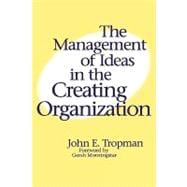
| Foreword | ix | (2) | |||
|
|||||
| Preface | xi | (4) | |||
| Acknowledgments | xv | ||||
| Part I Ideas and Organizations/Organizations and Ideas | 3 | (32) | |||
|
3 | (6) | |||
|
7 | (2) | |||
|
9 | (8) | |||
|
9 | (6) | |||
|
15 | (1) | |||
|
16 | (1) | |||
|
16 | (1) | |||
|
17 | (18) | |||
|
17 | (1) | |||
|
18 | (3) | |||
|
21 | (2) | |||
|
23 | (5) | |||
|
28 | (3) | |||
|
31 | (4) | |||
| Part II The Fatal Glass of Beer | 35 | (26) | |||
|
35 | (10) | |||
|
35 | (5) | |||
|
40 | (4) | |||
|
44 | (1) | |||
|
45 | (6) | |||
|
45 | (1) | |||
|
46 | (1) | |||
|
46 | (1) | |||
|
47 | (1) | |||
|
48 | (1) | |||
|
48 | (1) | |||
|
48 | (1) | |||
|
49 | (2) | |||
|
51 | (10) | |||
|
51 | (1) | |||
|
52 | (4) | |||
|
56 | (1) | |||
|
57 | (4) | |||
| Part III Helping New Ideas Along through Leading and Managing | 61 | (26) | |||
|
61 | (8) | |||
|
61 | (2) | |||
|
63 | (2) | |||
|
65 | (3) | |||
|
68 | (1) | |||
|
69 | (4) | |||
|
70 | (1) | |||
|
71 | (1) | |||
|
71 | (2) | |||
|
73 | (14) | |||
|
73 | (8) | |||
|
81 | (6) | |||
| Part IV Helping Ideas Along through Team and Decision Leadership and Management | 87 | (34) | |||
|
87 | (14) | |||
|
87 | (2) | |||
|
89 | (2) | |||
|
91 | (7) | |||
|
98 | (1) | |||
|
99 | (2) | |||
|
101 | (8) | |||
|
102 | (1) | |||
|
103 | (1) | |||
|
104 | (1) | |||
|
105 | (1) | |||
|
105 | (1) | |||
|
106 | (1) | |||
|
107 | (2) | |||
|
109 | (12) | |||
|
109 | (1) | |||
|
109 | (1) | |||
|
110 | (1) | |||
|
110 | (5) | |||
|
115 | (6) | |||
| Part V The Power of 11: From Art to Part-From Concept to Customer | 121 | (130) | |||
|
121 | (8) | |||
|
122 | (1) | |||
|
123 | (1) | |||
|
124 | (1) | |||
|
125 | (1) | |||
|
126 | (1) | |||
|
127 | (1) | |||
|
127 | (2) | |||
|
129 | (22) | |||
|
129 | (9) | |||
|
138 | (3) | |||
|
141 | (4) | |||
|
145 | (5) | |||
|
150 | (1) | |||
|
150 | (1) | |||
|
151 | (10) | |||
|
151 | (4) | |||
|
155 | (4) | |||
|
159 | (1) | |||
|
159 | (2) | |||
|
161 | (16) | |||
|
161 | (1) | |||
|
162 | (1) | |||
|
163 | (2) | |||
|
165 | (7) | |||
|
172 | (3) | |||
|
175 | (1) | |||
|
175 | (1) | |||
|
175 | (2) | |||
|
177 | (10) | |||
|
177 | (1) | |||
|
178 | (1) | |||
|
179 | (1) | |||
|
180 | (1) | |||
|
181 | (4) | |||
|
185 | (2) | |||
|
187 | (22) | |||
|
187 | (1) | |||
|
188 | (3) | |||
|
191 | (5) | |||
|
196 | (1) | |||
|
197 | (2) | |||
|
199 | (2) | |||
|
201 | (3) | |||
|
204 | (3) | |||
|
207 | (1) | |||
|
208 | (1) | |||
|
209 | (8) | |||
|
210 | (1) | |||
|
210 | (4) | |||
|
214 | (2) | |||
|
216 | (1) | |||
|
217 | (10) | |||
|
217 | (1) | |||
|
218 | (8) | |||
|
226 | (1) | |||
|
227 | (16) | |||
|
227 | (1) | |||
|
228 | (1) | |||
|
228 | (1) | |||
|
229 | (6) | |||
|
235 | (1) | |||
|
235 | (7) | |||
|
242 | (1) | |||
|
243 | (8) | |||
|
243 | (7) | |||
|
250 | (1) | |||
| References | 251 | (8) | |||
| Index | 259 |
The New copy of this book will include any supplemental materials advertised. Please check the title of the book to determine if it should include any access cards, study guides, lab manuals, CDs, etc.
The Used, Rental and eBook copies of this book are not guaranteed to include any supplemental materials. Typically, only the book itself is included. This is true even if the title states it includes any access cards, study guides, lab manuals, CDs, etc.